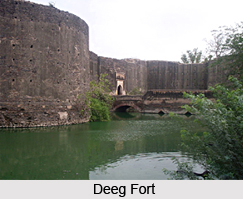 The Deeg fort is one of the most important monuments of Deeg, in terms of its interesting history and marvelous architecture. The massive bastion of Deeg was constructed by Suraj Mai, the great ruler of Bharatpur. It lies to the east of Rup Sagar, beyond the Shish-Mahal of Deeg. The dreadful construction was built to prevent the enemies advancing towards Deeg.
The Deeg fort is one of the most important monuments of Deeg, in terms of its interesting history and marvelous architecture. The massive bastion of Deeg was constructed by Suraj Mai, the great ruler of Bharatpur. It lies to the east of Rup Sagar, beyond the Shish-Mahal of Deeg. The dreadful construction was built to prevent the enemies advancing towards Deeg.
History of the Deeg Fort
When Badan Singh was announced his rule in 1722, Deeg was the first capital of the newly fixed out Jat state of Bharatpur and after that Maharaja Suraj Mal raised the strong citadel of Deeg. Then Suraj Mal moved the capital to Bharatpur and Deeg became the second capital of the monarchs of Bharatpur princely state.
Throughout the year 1804, both the Battle of Deeg and the blockade of Deeg brought the British East India Company into disagreement with Bharatpur`s Jat rulers and their Maratha associates for the power of the area.
Architecture of the Deeg Fort
The Deeg fort is designed as a square and stands on a slightly elevated ground. Its walls are made of rubble and mud and are strengthened with twelve imposing towers, which are the most impressive features of the Deeg fort. The largest tower is known as Lakha-Burj that is located in the North West corner. These towers were fixed with cannons to hunt down any advancing enemy. The entire Deeg fort is surrounded by a shallow wide moat to which access is possible through a bridge on the northern side linked with the only gate. The gateway to the fort is confined with anti elephant strikes. On the exterior the walls were layered with plaster which in many places has peeled off.
A partially ruined palace or haveli is the principal building of Deeg fort. Some parts of the palace have been re-constructed in the 20th century almost like the original. The palace has a court covered by compartments. The use of red sandstones and pointed arch of the palace is remarkable. The other significant structures of the fort include certain underground chambers, the tomb of Muhammad Shafi, a Mughal Mir-bakshi.
Attractions of the Deeg Fort
With its 900 fountains, which operate twice a year during the avamasaya festivals in February & September, Deeg Palace museum is closed on friday, Deeg palace is the famous and popular tourist spot. Another attraction is The Chhattri of Sultan Singh, one of the brothers of Suraj Mai, is also a major attraction.
Connectivity of the Deeg Fort
Both bus and train facilities are available. Buses are accessible from places like Jaipur, Bharatpur, Alwar, Mathura and New Delhi and slow trains are available from Alwar and Mathura. Deeg railway station lies on the Mathura-Alwar railway line that caters mainly to freight trains and also slow train service from Jaipur. The Nearest Airport is Delhi and can be reaching in 3-4 hours.



















